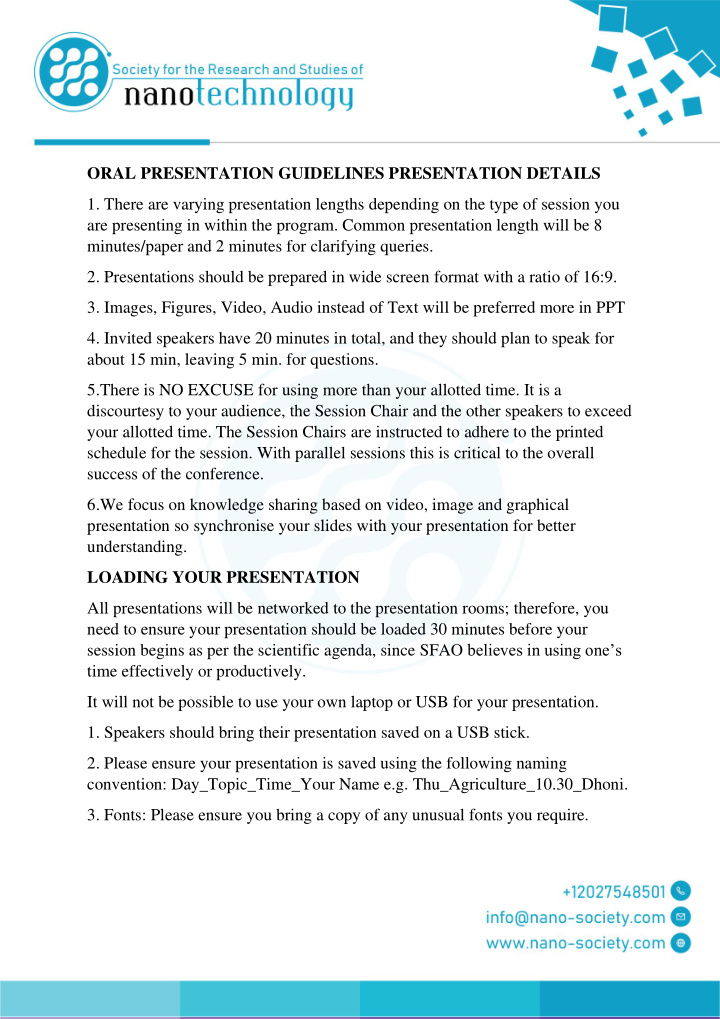



ORAL PRESENTATION GUIDELINES PRESENTATION DETAILS 1. There are varying presentation lengths depending on the type of session you are presenting in within the program. Common presentation length will be 8 minutes/paper and 2 minutes for clarifying queries. 2. Presentations should be prepared in wide screen format with a ratio of 16:9. 3. Images, Figures, Video, Audio instead of Text will be preferred more in PPT 4. Invited speakers have 20 minutes in total, and they should plan to speak for about 15 min, leaving 5 min. for questions. 5.There is NO EXCUSE for using more than your allotted time. It is a discourtesy to your audience, the Session Chair and the other speakers to exceed your allotted time. The Session Chairs are instructed to adhere to the printed schedule for the session. With parallel sessions this is critical to the overall success of the conference. 6.We focus on knowledge sharing based on video, image and graphical presentation so synchronise your slides with your presentation for better understanding. LOADING YOUR PRESENTATION All presentations will be networked to the presentation rooms; therefore, you need to ensure your presentation should be loaded 30 minutes before your session begins as per the scientific agenda, since SFAO believes in using one’s time effectively or productively. It will not be possible to use your own laptop or USB for your presentation. 1. Speakers should bring their presentation saved on a USB stick. 2. Please ensure your presentation is saved using the following naming convention: Day_Topic_Time_Your Name e.g. Thu_Agriculture_10.30_Dhoni. 3. Fonts: Please ensure you bring a copy of any unusual fonts you require.
4. 3rd Party Software. Bring a copy of any industry specific software that you may require. 5. We suggest the presenting author to bring his/her own Laptop and a USB drive with presentation materials as backup. 6. If you have movies or sound files in the PowerPoint presentation please embed these within your PowerPoint. 7. Please also bring a copy of the sound or movie files on a USB in case they are lost on different versions of PowerPoint or have become corrupt during transit. 8. Advise the speaker’s preparation, so that you can move files immediately upon your arrival at the …….< Conference Venue>……, so that the integrity of the files can be checked on the scientific sessions network in plenty of time ahead of your session. 9. Ensure that you have the correct AVI codecs saved with the video/audio file presentation. If you have any questions, please contact ent@bioleagues.com 10. In addition to the default “.pptx” file format, we suggest that you also save a copy of your presentations in the “.ppsx” (PowerPoint Show) format (the “.ppsx” version may also include some of the special fonts in your presentations). we suggest you save your presentations into a “.pdf” format file also. Good Practices • Show no more than 1 slide per minute of speaking time. This means approximately 10-12 slides MAXIMUM for the 10 minutes presentation at the symposium. Remember, the last two minutes of the presentation are for questions from the audience. It detracts from the quality of the presentation to flash numerous graphs, equations, or tables on the screen in rapid sequence to squeeze a presentation into its allotted time. • We recommend a presentation format of 16:9, 4:3 is also acceptable.
• Make the letters on your slides BIG ENOUGH. Suggested minimum font is 14. • Put no more than 12 lines of text or 4 curves on any slide. • Avoid lengthy tabulations of numerical data and limit equations to those for which the terms can be properly defined. • Your audience needs time to interpret the data that you present. While you are very familiar with the data displayed, the audience is not. Describe the abscissa, coordinates, units and the legend for each curve. • When you display a curve, tell the audience what they should be looking for in order to grasp the point you are trying to make. The audience will not have time to figure it out for themselves. • Use repetition in your talk to ensure the facts are understood by the audience. • In addition to the body of the talk, present an introduction and a summary or conclusion. • Include only information or data that can be properly explained in the allotted time. • Repeat any questions that are posed to you. • If a question requires a lengthy reply, suggest that you and the person asking the question meet after the presentation. Then take the discussion out of the meeting room
Recommend
More recommend